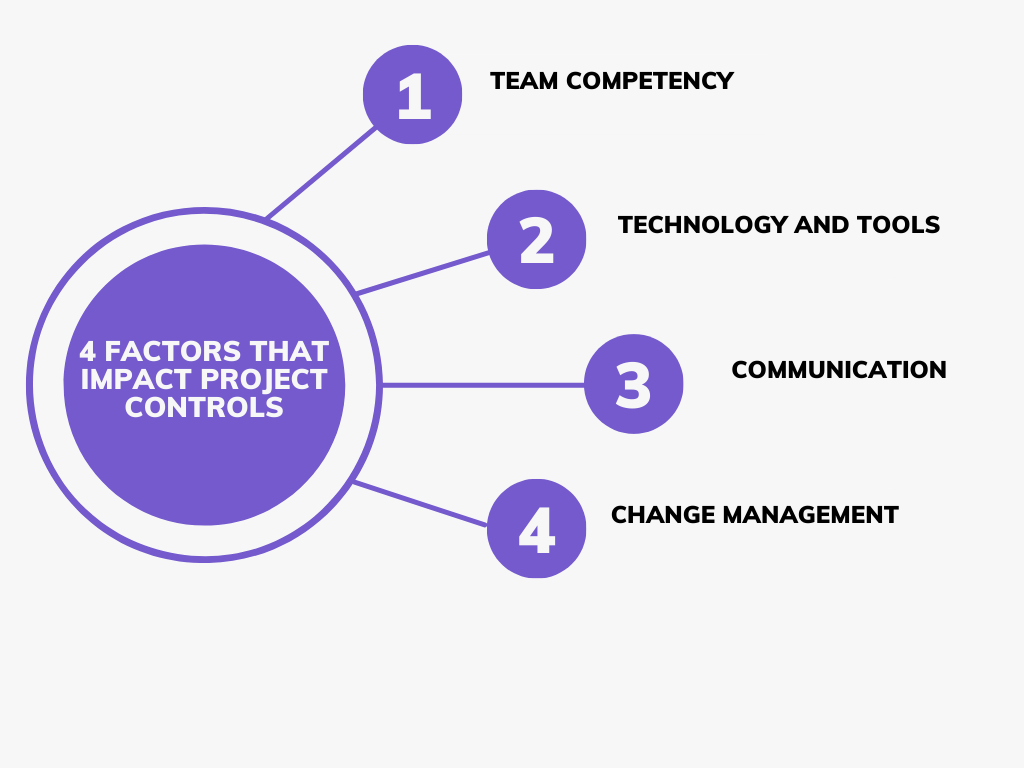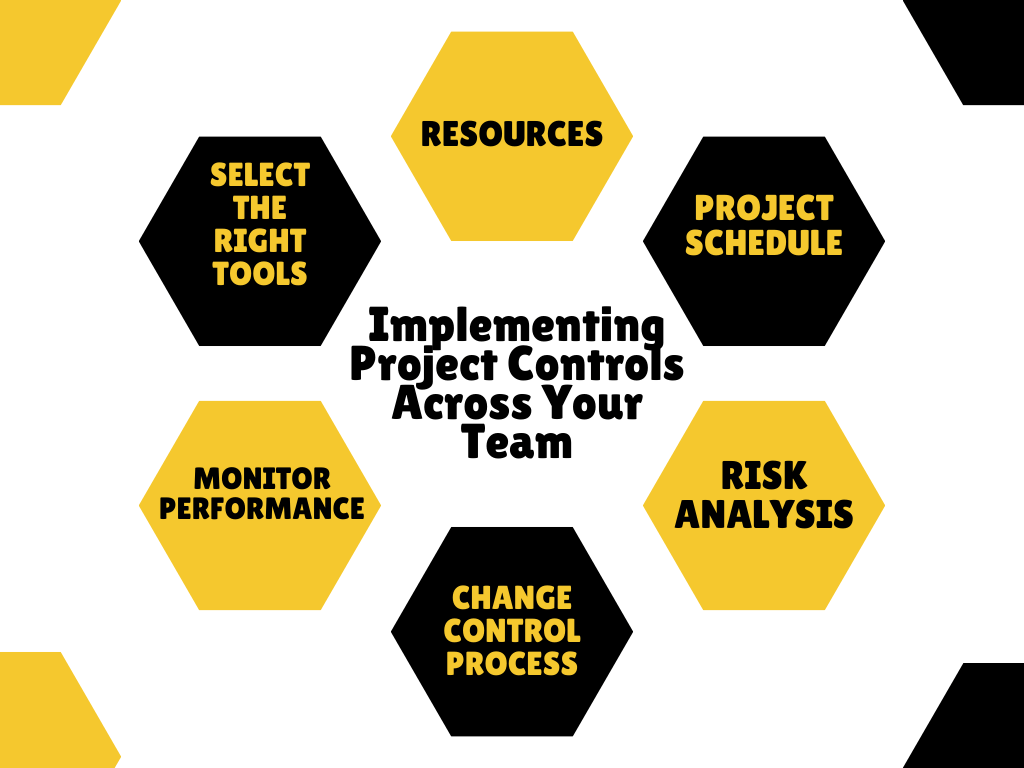Exceeding the budget is a widespread issue, frequently resulting in delayed project completion. These two factors combined serve as indicators of an unsuccessful project.
Regrettably, only 43% of projects manage to evade this widespread problem. Curious about the reason? This is primarily due to the absence of effective and firmly established project controls.
Thankfully, implementing them is not a complex task. So, continue reading as this article guides you through its essence and offers practical advice for implementation!
Table of Content
- Introduction:
- What are Project Controls?
- Project Controls vs. Project Management: What’s the Difference?
- The Importance of Project Controls in Project Management
- 4 Factors That Impact Project Controls
- How To Implement Project Controls Across Your Team
- Manage Project Controls with a Work Breakdown Structure
- Conclusion
- FAQs
- For Further Reading
Introduction:
In the ever-changing field of project management, staying on the cutting edge is crucial to ensuring that your projects are delivered successfully. One of the critical elements that play a pivotal role in achieving this success is the effective implementation of project controls.
In this article, we’ll take a deep dive into the world of project controls. We’ll explore what they entail, how they differ from traditional project management, their vital significance within the project management domain, the various factors that influence them, and practical strategies for integrating them seamlessly within your team’s workflow.
Furthermore, we’ll also touch upon the pivotal role played by a Work Breakdown Structure (WBS) in effectively managing project controls.
Project Controls
These controls refer to the processes and tools used to plan, monitor, and manage a project’s performance. These controls are essential for ensuring that a project stays on track in terms of budget, schedule, and quality.
They encompass a wide range of activities, including cost estimation, scheduling, risk management, and performance measurement. They also act as a guiding force, helping project managers make informed decisions throughout the project’s lifecycle.
These controls involve the following key components:
- Cost Control: Monitoring and managing project expenditures to ensure they align with the budget.
- Schedule Control: Tracking project timelines and milestones to ensure they are met.
- Scope Control: Managing project scope changes and ensuring alignment with the original objectives.
- Quality Control: Ensuring that project deliverables meet predefined quality standards.
- Risk Management: Identifying and mitigating potential risks that may impact the project’s success.
How Important are Project Controls in Project Management
These controls are pivotal to project management success. Here are some compelling reasons why they play a critical role:
- Risk Mitigation: They help identify potential issues early in the project, allowing for timely intervention and risk mitigation.
- Cost Management: They ensure that the project stays within budget by tracking expenditures and controlling costs.
- Schedule Adherence: They help maintain project schedules, reducing the risk of delays.
- Quality Assurance: They ensure that the project’s deliverables meet the required quality standards.
- Data-Driven Decision-Making: They provide valuable data and insights, enabling informed decision-making.
- Stakeholder Confidence: They also inspire confidence among stakeholders, as they can see that the project is being managed and monitored meticulously.
Project Management vs. Project Controls: How are they different?
Project Management is the broader discipline that encompasses planning, execution, and monitoring of a project. It involves defining project goals, allocating resources, and ensuring that the project is completed successfully.
Project managers are responsible for coordinating the entire project and making sure it meets its objectives.
Project Controls, on the other hand, are a subset of project management. They focus specifically on tracking and regulating project performance.
They also provide project managers with the necessary information and tools to make decisions and adjustments as needed to keep the project on course.
In essence, project management sets the project’s direction and goals, while project controls keep it on track by monitoring, analyzing, and optimizing various project parameters.
Factors Impacting Project Controls

Project controls play a pivotal role in the successful execution of any project. However, their effectiveness can be influenced by various factors that project managers must consider.
In this section, we will explore four key factors that impact these controls and how addressing these factors can lead to better project outcomes.
1. Team Competency
The competency of your project team is a critical factor that can significantly influence the success of project controls. A skilled and knowledgeable team is better equipped to plan, execute, and monitor a project effectively. Here’s how team competency impacts these controls:
- Decision-Making: Competent team members are more likely to make informed decisions when faced with challenges or deviations from the project plan. They can analyze data, assess risks, and propose effective solutions.
- Risk Management: A competent team is better prepared to identify potential risks early in the project. They can conduct thorough risk assessments, develop mitigation strategies, and respond swiftly to emerging risks.
- Communication: Competent team members can communicate effectively within the team and with stakeholders. Clear and concise communication is essential for conveying project control information, status updates, and critical issues.
To address this factor, invest in training and development programs for your project team. Ensure that team members acquire the necessary skills and knowledge to excel in their roles. Regularly assess and update their competencies to stay aligned with industry best practices.
2. Technology and Tools
The tools and technology used for project controls can significantly impact their effectiveness. Modern project management softwares and tools provide real-time data, facilitate collaboration, and streamline control processes. Here’s how technology and tools influence these controls:
- Data Accuracy: Project management softwares can capture and analyze project data accurately, reducing the risk of errors and inconsistencies in reporting.
- Collaboration: Collaborative tools enable team members to work together seamlessly, share information, and provide real-time updates, enhancing project control communication.
- Automation: Automation features in project management tools can streamline routine tasks, allowing project managers to focus on critical control activities.
- Reporting: Robust reporting capabilities provide project managers with the insights they need to make informed decisions and adjustments.
To address this factor, carefully select project management and control tools that align with your project’s specific requirements. Ensure that your team is trained to use these tools effectively and leverage their full potential.
3. Communication
Effective communication is a cornerstone of successful project controls. It ensures that relevant information flows freely among team members, stakeholders, and project managers. Timely updates and reporting are critical for staying informed and making informed decisions. Here’s how communication impacts these controls:
- Information Flow: Open and transparent communication channels help disseminate project control information, ensuring that all stakeholders are on the same page.
- Issue Resolution: Effective communication enables the quick identification and resolution of project issues and challenges.
- Decision-Making: Well-communicated data and insights empower project managers to make informed decisions based on accurate information.
To address this factor, establish clear lines of communication within your project team. Define communication protocols, reporting structures, and escalation paths. Encourage a culture of open communication where team members feel comfortable sharing updates and raising concerns.
4. Change Management
Change is inevitable in any project, and how you manage and adapt to change can significantly affect project controls. Unplanned changes in scope, resources, or timelines can disrupt the project’s trajectory. Here’s how change management influences these controls:
- Impact Assessment: Effective change management involves assessing the impact of proposed changes on project controls. This includes evaluating potential risks, cost implications, and scheduling adjustments.
- Documentation: Changes should be documented, tracked, and communicated to all relevant stakeholders to maintain transparency and accountability.
- Integration: Changes should be seamlessly integrated into the existing project control framework, ensuring that they do not compromise the project’s overall goals.
- Risk Mitigation: Change management strategies should include risk mitigation plans to address any new risks introduced by changes.
Incorporating Project Controls Across Your Team

Implementing project controls across your team involves a structured approach to ensure that your project stays on track and meets its objectives. Here are six key points that guide the implementation of project controls:
1. Project Schedule
A well-defined project schedule is the backbone of project controls. It outlines the sequence of tasks, milestones, and timelines. Here’s how to manage the project schedule effectively:
- Detailed Planning: Develop a comprehensive project schedule that breaks down the work into manageable tasks with defined durations. Ensure that dependencies between tasks are accurately identified.
- Schedule Monitoring: Regularly monitor project progress against the schedule. Identify deviations and assess their impact on the overall timeline. Adjust the schedule as needed to accommodate changes.
- Critical Path Analysis: Identify the critical path—the sequence of tasks with the least flexibility in terms of time. Focus your attention on managing tasks along the critical path to prevent project delays.
A well-maintained project schedule helps you meet project deadlines, allocate resources efficiently, and make informed decisions when faced with schedule-related challenges.
2. Resources
Effective resource management is crucial for the successful implementation of project controls. Resources encompass personnel, equipment, materials, and budget. Here’s how to manage resources effectively:
- Resource Allocation: Determine the resources required for each project phase and allocate them accordingly. This includes assigning the right team members with the necessary skills to specific tasks and ensuring that equipment and materials are available when needed.
- Resource Tracking: Continuously monitor resource utilization throughout the project. Identify over-allocated or under-allocated resources and make necessary adjustments to optimize resource usage.
- Budget Management: Track project expenditures and compare them against the allocated budget. Implement cost controls to ensure that the project stays within its financial constraints.
By efficiently managing resources, you can prevent bottlenecks, minimize delays, and maintain project cost-effectiveness.
3. Risk Analysis
Risk analysis is integral to project controls as it allows you to identify, assess, and mitigate potential risks that could affect the project’s success. Here’s how to approach risk analysis:
- Risk Identification: Collaboratively identify all potential risks, both internal and external, that could impact the project. These risks may relate to scope changes, resource availability, market conditions, or technological challenges.
- Risk Assessment: Evaluate each identified risk in terms of its likelihood and potential impact on the project’s objectives. Prioritize risks based on their significance.
- Risk Mitigation: Develop risk mitigation strategies and contingency plans for high-priority risks. Implement preventive actions to reduce the likelihood of risks occurring and corrective actions to address risks that materialize.
- Continuous Monitoring: Regularly review and update the risk register throughout the project’s lifecycle. New risks may emerge, and the significance of existing risks may change.
A robust risk analysis and management process helps you proactively address challenges, reduce uncertainties, and safeguard project outcomes.
4. Change Control Process
Change is inevitable in any project. An effective change control process ensures that changes are managed systematically without compromising project controls. Here’s how to establish an efficient change control process:
- Request Submission: Create a standardized process for submitting change requests. Require detailed information about the proposed change, including its impact on scope, schedule, resources, and budget.
- Review and Evaluation: Establish a change review board or committee responsible for evaluating change requests. Assess the requested changes’ necessity, impact, and feasibility.
- Approval and Documentation: Approved changes should be documented, and all relevant stakeholders should be informed. Ensure that changes are integrated into the project controls framework.
- Communication: Maintain transparent communication regarding approved changes to prevent confusion and ensure that all team members and stakeholders are aware of modifications to the project plan.
5. Select the Right Tools
Here’s how to choose the right tools for the job:
- Tool Evaluation: Research and evaluate project management software and tools that align with your project’s needs. Pay attention to features like scheduling, budget tracking, risk management, and reporting capabilities.
- Training and Implementation: Ensure that your team is trained to use the selected tools effectively. Implement a smooth transition to the new tools, minimizing disruptions.
- Integration: If you’re using multiple tools, ensure they can integrate seamlessly to facilitate data sharing and collaboration.
Selecting the right tools simplifies project control processes, enhances data accuracy, and improves communication among team members.
6. Monitor Performance
Continuous performance monitoring is a cornerstone of effective project controls. It involves tracking various project parameters, including cost, schedule, quality, and risk. Here’s how to monitor performance:
- Key Performance Indicators (KPIs): Define and track KPIs that align with your project’s objectives. These KPIs may include budget variances, schedule adherence, defect rates, and risk levels.
- Regular Reporting: Establish a reporting mechanism that provides regular updates on project performance. Reports should highlight achievements, deviations, and any required corrective actions.
- Data Analysis: Analyze project data to identify trends, patterns, and potential areas of concern. Enhance your decision-making process with the valuable guidance of data-driven insights.
- Performance Reviews: Conduct periodic performance reviews with your project team to discuss progress, challenges, and opportunities for improvement.
How to Manage Project Controls with a WBS?

A Work Breakdown Structure (WBS) serves as a structured hierarchy that outlines the tasks and deliverables within a project. It breaks down the project into manageable components, making it easier to plan, execute, and control.
What is a WBS?
A WBS organizes the project into smaller, more manageable pieces, called work packages. Each work package represents a specific task or deliverable within the project. By breaking the project down into these smaller components, project managers gain better visibility into project details, making it easier to control.
How Does a WBS Support Project Controls?
- Improved Planning: A WBS enables thorough project planning by identifying all tasks and deliverables. This detailed planning is essential for effective project controls.
- Resource Allocation: With a WBS, you can allocate resources more efficiently to specific work packages, ensuring that the right resources are available when needed.
- Tracking Progress: The WBS provides a baseline against which you can track progress. By comparing actual progress to the planned work packages, project controls become more precise.
- Issue Identification: If an issue arises within a specific work package, it’s easier to isolate and address. This prevents issues from cascading throughout the project.
- Cost Control: A WBS can be used to allocate costs to individual work packages, aiding in cost control and budget management.
Conclusion
In conclusion, effective project controls are indispensable for project success in 2024 and beyond. They provide the necessary tools and processes to manage, monitor, and adapt to the dynamic nature of project management.
By understanding the fundamentals of project controls, differentiating them from project management, recognizing their importance, addressing key influencing factors, implementing them effectively, and leveraging tools like the Work Breakdown Structure, you can elevate your project management game.
FAQs
1. What are the 5 project controls?
The five project controls are cost control, schedule control, scope control, quality control, and risk management. These controls help project managers plan, monitor, and manage various aspects of a project to ensure its success.
2. What are 3 control mechanisms plans that a project manager uses to keep the project on course?
Three control mechanisms plans that project managers use to keep a project on course are:
1. Ensuring that the right resources are available when needed to avoid bottlenecks.
2. Regularly tracking project progress against the schedule to identify and address deviations.
3. Identifying, assessing, and mitigating potential risks that could impact the project’s success.
3. What are project controls and how do they contribute to a successful project?
These controls are processes and tools used to plan, monitor, and manage a project’s performance. They contribute to a successful project by providing project managers with the necessary information to make informed decisions, mitigate risks, stay within budget, meet deadlines, and deliver high-quality results.
4. What are the four basic actions to control projects?
The four basic actions to control projects are:
1. Establish clear project objectives and key performance indicators (KPIs) for success.
2. Continuously track project performance against established KPIs and objectives.
3. Manage changes systematically, ensuring they are integrated into the project framework.
4. Make data-driven decisions and leverage appropriate project management and control tools to enhance project management effectiveness.

